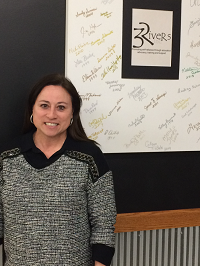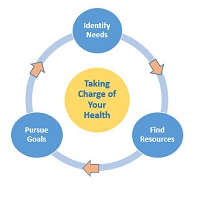Developing a Health Promotion Assistance Tool Mary Herrick: Partner Success Story
This information is available in PDF format upon request.
Partners in Research
The Research & Training Center on Community Living is grateful to the many staff members from centers for independent living and other community-based organizations and the consumers who partner on our research to enhance community living. Here is one partner’s story.
 Partner Success Story: Mary Herrick
Partner Success Story: Mary Herrick
“You guys are on the verge of something amazing! The HAIL program is going to go well with people with disabilities who want to stay home instead of entering an institution.”
- Mary Herrick, Independent Living Specialist, Three Rivers Independent Living Center, Wamego, Kansas
Research in Action
A veteran with traumatic brain and spinal cord injuries was tired of relying on pain medications and marijuana, but they were his only solutions — that was, until Mary Herrick helped him discover HAIL (Health Access for Independent Living), a new health promotion assistance tool.
Herrick, an independent living specialist from Three Rivers Independent Living Center in Wamego, Kansas, was one of the Center for Independent Living advocates who partnered on testing HAIL with researchers Jean Ann Summers, PhD, Dot Nary, PhD, Aruna Subramaniam, MS, and Alice Zhang, MA.
Their mission: to help people with physical disabilities understand and manage their own health care — which is important because these consumers have significant health disparities compared to people without disabilities, and oftentimes also have secondary health conditions.
“For consumers, the goals are to learn to recognize and address secondary health conditions, to set and achieve short-term health-related goals, and to develop skills to be empowered healthcare consumers — which is extremely important for people with disabilities,” Nary said.
 CIL staff play a key role in helping HAIL consumers improve their health and gain new skills. “Independent living center staff are trusted sources of information for many consumers, which is why we designed HAIL to be delivered through CILs,” said Jean Ann Summers. “For the design, we also wanted CIL input on what is practical and useful for program staff.”
CIL staff play a key role in helping HAIL consumers improve their health and gain new skills. “Independent living center staff are trusted sources of information for many consumers, which is why we designed HAIL to be delivered through CILs,” said Jean Ann Summers. “For the design, we also wanted CIL input on what is practical and useful for program staff.”
Herrick worked the HAIL process with her consumers by first identifying their health-related goals. Then they used the HAIL database to find resources specific to each person’s health conditions and needs. Consumers can choose both medical and non-medical interventions, including social, psychological and physical approaches.
Then they made plans to achieve the newly set goals. The veteran who needed pain relief wanted to find alternative solutions to pain medications and marijuana. He and Herrick searched the HAIL database for options, discovering exercise and yoga — both things he was interested in. Within months of working with a trainer and utilizing other HAIL resources, he was walking with a straighter back, taking less pain medication and no longer using marijuana.
Herrick saw similar results with a female consumer enrolled in the HAIL trial. The woman was using a wheelchair after experiencing a spinal cord injury and a stroke, but she wanted to take a few steps again. Together they set goals and found strategies, and the woman was highly motivated to exercise.
Weeks later, the consumer asked Herrick, “You want to see what I’m doing?” Herrick laughed as she recalled: “She put her hands on the table and stood up. She had been exercising so much, that she started to get a little bit of momentum for taking steps, even though she had left-sided weakness. It was amazing.”
“Those two individuals are now on the path to wellness instead of just having something fixed as they might encounter in the medical model,” said Jamie Simpson, an advisor to the research center. “Now they have the resources, the tools and this push start to really take control of their own health and well-being.”
For more Information:
Jean Ann Summers, PhD
jsummers@ku.edu
or
Dot Nary, PhD
dotn@ku.edu
785-864-4095
University of Kansas
The contents of this document were developed under a grant from the National Institute on Disability, Independent Living, and Rehabilitation Research (NIDILRR grant number 90RT5015). NIDILRR is a Center within the Administration for Community Living (ACL), Department of Health and Human Services (HHS). These contents do not necessarily represent the policy of NIDILRR, ACL, or HHS, and you should not assume endorsement by the Federal Government.
©2017